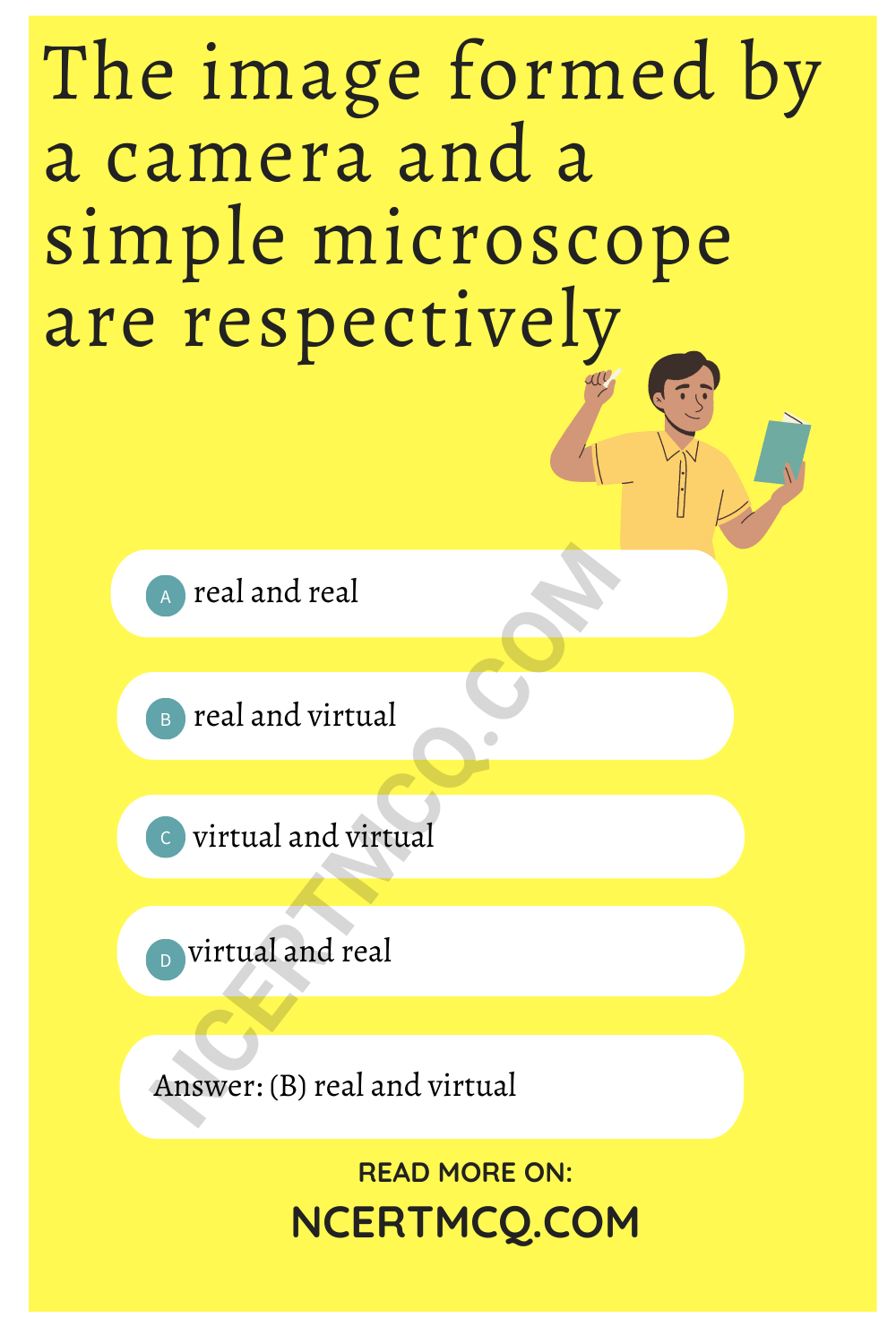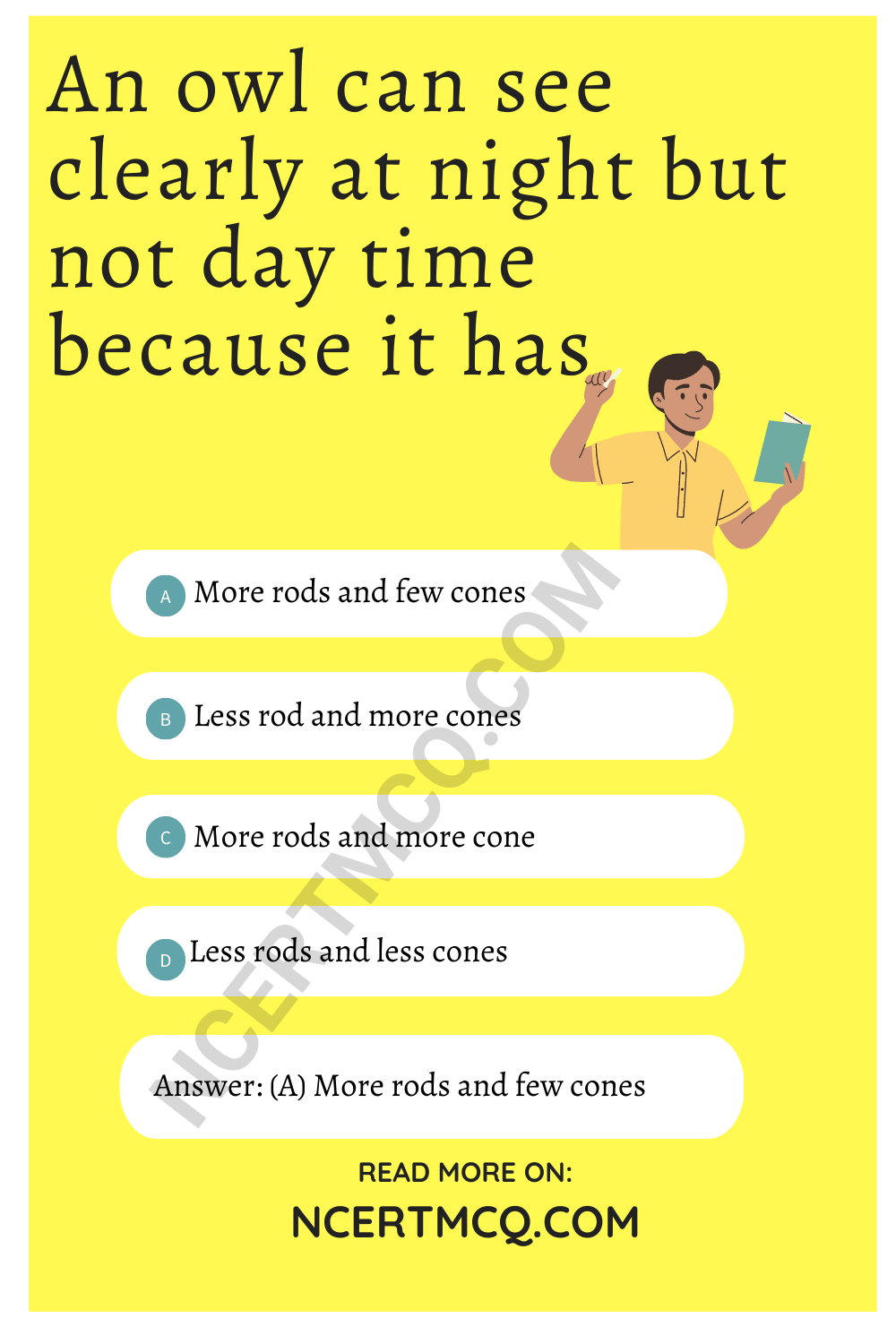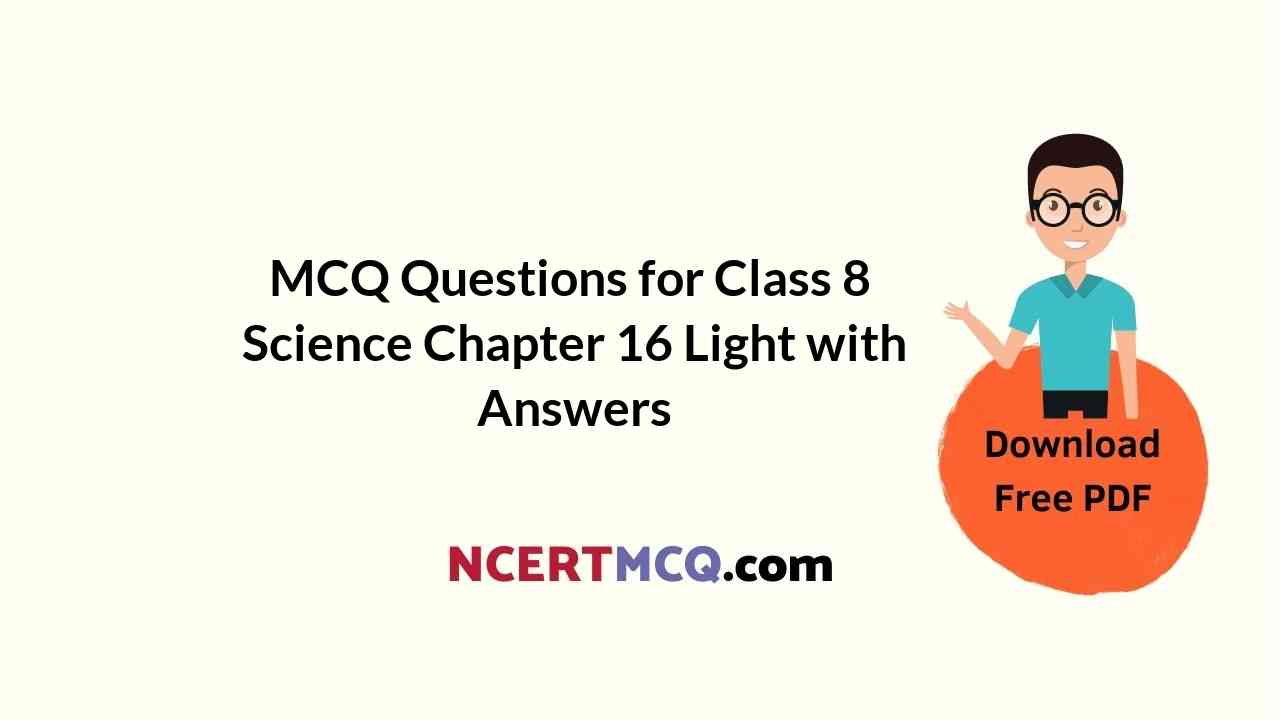Check the below Online Education NCERT MCQ Questions for Class 8 Science Chapter 16 Light with Answers Pdf free download. MCQ Questions for Class 8 Science with Answers were prepared based on the latest exam pattern. We have provided Light Class 8 Science MCQs Questions with Answers to help students understand the concept very well. https://ncertmcq.com/mcq-questions-for-class-8-science-with-answers/
You can refer to NCERT Solutions for Class 8 Science Chapter 16 Light to revise the concepts in the syllabus effectively and improve your chances of securing high marks in your board exams.
Class 8 Science Chapter 16 MCQ With Answers
Science Class 8 Chapter 16 MCQs On Light
Choose the correct option in the following questions:
Light Class 8 MCQ Question 1.
A smooth shining surface, which rebounds the light back in same or in different direction, is called
(a) a mirror
(b) a lens
(c) reflection of light
(d) point of incidence
Answer
Answer: (a) a mirror
Light MCQ Class 8 Question 2.
Beam of light striking the reflecting surface is called
(a) reflecting ray
(b) incident ray
(c) refracted ray
(d) normal ray
Answer
Answer: (b) incident ray
Class 8 Science Chapter 16 MCQ Question 3.
Band of seven colours is called
(a) VIBGYOR
(b) spectrum
(c) dispersion
(d) reflection
Answer
Answer: (b) spectrum
MCQ On Light Class 8 Question 4.
Front balged part of the eyeball is called
(a) cornea
(b) choroid
(c) pupil
(d) retina
Answer
Answer: (a) cornea
Class 8 Light MCQ Question 5.
Which one of the following statements is correct regarding rods and cones in the human eye?
(a) Cones are sensitive to dim light
(b) Cones are sensitive to bright light
(c) Rods are sensitive to bright light
(d) Rods can sense colour
Answer
Answer: (b) Cones are sensitive to bright light
MCQ Of Light Class 8 Question 6.
In case of reflection of light, the angle of incidence (i) and the angle of reflection (r) are related as
(a) i = r
(b) i < r
(c) i > r
(d) no definite relation
Answer
Answer: (a) i = r
Class 8 Science Light MCQ Question 7.
Name the type of mirror used as a backview mirror.
(a) Plane mirror
(b) Concave mirror
(c) Convex mirror
(d) Any of these
Answer
Answer: (c) Convex mirror
Class 8 Science Ch 16 MCQ Question 8.
Visually impaired people can read and write using
(a) electronic writer
(b) digital pens
(c) braille system
(d) hearing aids
Answer
Answer: (c) braille system
Refraction And Dispersion Of Light Class 8 MCQ Question 9.
The image formed by a camera and a simple microscope are respectively
(a) real and real
(b) real and virtual
(c) virtual and virtual
(d) virtual and real
Answer
Answer: (b) real and virtual

Light Chapter Class 8 MCQ Question 10.
What is the angle of incidence of a ray if the reflected ray is at an angle of 90° to the incident ray?
(a) 60°
(b) 45°
(c) 90°
(d) 180°
Answer
Answer: (b) 45°
MCQ On Light Class 8 Pdf Question 11.
The splitting of white light into its seven constituent colours is called
(a) refraction
(b) dispersion
(c) deviation
(d) reflection
Answer
Answer: (b) dispersion
MCQs On Light Class 8 Question 12.
The defect due to which a person is not able to see the distant objects clearly:
(a) Myopia
(b) Hypermetropia
(c) Cornea
(d) Cataract
Answer
Answer: (a) Myopia
Class 8 Science Chapter Light MCQ Question 13.
The amount of light entering the eye is controlled by
(a) eye lens
(b) cornea
(c) iris
(d) ciliary muscle
Answer
Answer: (c) iris
MCQs Of Light Class 8 Question 14.
Myopia can be corrected by using a
(a) concave lens
(b) convex lens
(c) opaque lens
(d) micro lens
Answer
Answer: (a) concave lens
Ch 16 Science Class 8 MCQ Question 15.
Light enters the eye through
(a) eye lens
(b) pupil
(c) cornea
(d) retina
Answer
Answer: (c) cornea
Reflection Of Light Class 8 MCQ Question 16.
If the angle of incidence of light falling on a plane mirror is 30°, what will be the angle of reflection?
(a) 90°
(b) 60°
(c) 30°
(d) 0°
Answer
Answer: (c) 30 degree
Question 17.
When we stand in front of our dressing table, our left hand seems to be right and right seems to be left. This is called
(a) Left-right confusion
(b) Lateral inversion
(c) Up -side down phenomenon
(d) mirage
Answer
Answer: (b) Lateral inversion
Question 18.
Light passing through a prism splits into seven colours. This is called
(a) Dispersion
(b) Dissolution
(c) Division
(d) None of the above
Answer
Answer: (a) Dispersion
Question 19.
Rainbow is a natural phenomenon showing
(a) Reflection
(b) Deflection
(c) Dispersion
(d) Diversion
Answer
Answer: (a) Reflection
Question 20.
In the retina of the eye, the area having no sensory cells is called
(a) iris
(b) Blind spot
(c) cornea
(d) Dark spot
Answer
Answer: (b) Blind spot
Question 21.
If light falls perpendicularly on a plane mirror, what will be the angle in which it will be reflected?
(a) 45°
(b) 90°
(c) 180°
(d) 360°
Answer
Answer: (c) 180 degrees
Question 22.
Which of the following is not a luminous object?
(a) sun
(b) candle
(c) moon
(d) Tube light
Answer
Answer: (c) moon
Question 23.
To make a kaleidoscope we require
(a) Three plane mirrors
(b) Four plane mirrors
(c) Three glass sheets
(d) Four glass sheets
Answer
Answer: (a) Three plane mirrors
Question 24.
In our eye _______ cells can sense colour
(a) Rod
(b) Cone
(c) Both rod and cone
(d) Neither rod nor cone
Answer
Answer: (b) Cone
Question 25.
An owl can see clearly at night but not day time because it has
(a) More rods and few cones
(b) Less rod and more cones
(c) More rods and more cone
(d) Less rods and less cones
Answer
Answer: (a) More rods and few cones

Match the following items given in Column A with that in Column ‘B’:
| Column A | Column B |
| (i) Cornea | (a) Transparent front part of eye |
| (ii) Pupil | (b) Layer on which impression of images is formed |
| (iii) Iris | (c) Point on retina where there are no nerve endings |
| (iv) Retina | (d) Sensitive for bright light |
| (v) Blind spot | (e) Is a small opening in the cornea |
| (vi) Rods | (f) Sensitive for dim light |
| (vii) Cones | (g) Controls the size of the pupil |
Answer
Answer:
| Column A | Column B |
| (i) Cornea | (a) Transparent front part of eye |
| (ii) Pupil | (e) Is a small opening in the cornea |
| (iii) Iris | (g) Controls the size of the pupil |
| (iv) Retina | (b) Layer on which impression of images is formed |
| (v) Blind spot | (c) Point on retina where there are no nerve endings |
| (vi) Rods | (f) Sensitive for dim light |
| (vii) Cones | (d) Sensitive for bright light |
Fill in the blanks with the appropriate words:
1. Impression of an image persists for …………. of the second on retina.
Answer
Answer: 1/6 th
2. Angle of reflection is always …………. to the angle of incidence.
Answer
Answer: equal
3. …………. is a small opening in the corner.
Answer
Answer: Pupil
4. Cones are sensitive to …………. light.
Answer
Answer: bright
5. Muscles attached to the eye lens …………. and the lens becomes …………. when distant objects are to be seen.
Answer
Answer: relax, thinner
6. To keep our eyes fit our diet should include vitamin …………. rich eatables.
Answer
Answer: A
7. Impression of an image in eye is formed on ………….
Answer
Answer: retina
8. Braille system has …………. dot patterns.
Answer
Answer: 63
State whether the statements given below are True or False:
1. Both incident ray and reflected ray lie in the same plane.
Answer
Answer: True
2. Diffused reflection is due to the failure of the laws of reflection.
Answer
Answer: False
3. The image formed by plane mirror is laterally inverted.
Answer
Answer: True
4. The iris is the coloured part of the eye.
Answer
Answer: True
5. Rods are sensitive to bright light.
Answer
Answer: False
6. Changing of the thickness of the eye lens is called accommodation.
Answer
Answer: True
We hope the given NCERT MCQ Questions for Class 8 Science Chapter 16 Light with Answers Pdf free download will help you. If you have any queries regarding Light CBSE Class 8 Science MCQs Multiple Choice Questions with Answers, drop a comment below and we will get back to you soon.
Class 8 Science MCQ:
- Crop Production and Management Class 8 MCQ
- Microorganisms: Friend and Foe Class 8 MCQ
- Synthetic Fibres and Plastics Class 8 MCQ
- Materials: Metals and Non-Metals Class 8 MCQ
- Coal and Petroleum Class 8 MCQ
- Combustion and Flame Class 8 MCQ
- Conservation of Plants and Animals Class 8 MCQ
- Cell Structure and Functions Class 8 MCQ
- Reproduction in Animals Class 8 MCQ
- Reaching the Age of Adolescence Class 8 MCQ
- Force and Pressure Class 8 MCQ
- Friction Class 8 MCQ
- Sound Class 8 MCQ
- Chemical Effects of Electric Current Class 8 MCQ
- Some Natural Phenomena Class 8 MCQ
- Light Class 8 MCQ
- Stars and the Solar System Class 8 MCQ
- Pollution of Air and Water Class 8 MCQ
